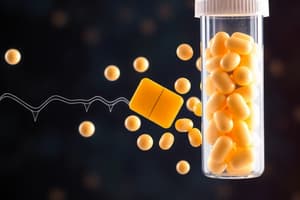Podcast
Questions and Answers
What does pharmacokinetics primarily focus on regarding drugs?
What does pharmacokinetics primarily focus on regarding drugs?
- The chemical structure of drugs and their synthesis
- The fate of the drug in the organism over time and dose (correct)
- The psychological effects of drugs on patients
- The social implications of drug use and distribution
What is the primary outcome of the liberation process in pharmacokinetics?
What is the primary outcome of the liberation process in pharmacokinetics?
- The drug being metabolized in the liver
- The drug entering the bloodstream
- The drug dissolving and being ready to absorb (correct)
- The elimination of the drug from the body
Which statement accurately describes metabolism in pharmacokinetics?
Which statement accurately describes metabolism in pharmacokinetics?
- It refers to reversible conversion of drugs into metabolites
- It is the irreversible transformation of compounds into metabolites (correct)
- It is solely about the elimination of drugs from the body
- It is the process of substances entering blood circulation
Which of the following processes is NOT part of the pharmacokinetic acronym ADME?
Which of the following processes is NOT part of the pharmacokinetic acronym ADME?
What aspect does distribution refer to in pharmacokinetics?
What aspect does distribution refer to in pharmacokinetics?
In which state does absorption primarily occur?
In which state does absorption primarily occur?
During which phase does the drug dissolve and become absorbable?
During which phase does the drug dissolve and become absorbable?
Which of the following correctly defines excretion in pharmacokinetics?
Which of the following correctly defines excretion in pharmacokinetics?
Which of the following factors increases the rate of drug absorption?
Which of the following factors increases the rate of drug absorption?
When comparing the absorption rates, which order correctly represents the fastest to slowest absorption from a drug administration perspective?
When comparing the absorption rates, which order correctly represents the fastest to slowest absorption from a drug administration perspective?
In terms of dosage form, how do absorption rates of various forms compare?
In terms of dosage form, how do absorption rates of various forms compare?
What defines an immediate or direct route of drug administration?
What defines an immediate or direct route of drug administration?
Which of the following correctly describes passive diffusion in drug absorption?
Which of the following correctly describes passive diffusion in drug absorption?
Which route of administration has the fastest onset of action?
Which route of administration has the fastest onset of action?
What is a significant disadvantage of parenteral routes of drug administration?
What is a significant disadvantage of parenteral routes of drug administration?
Which factor enhances oral drug absorption?
Which factor enhances oral drug absorption?
Why is the absorption from the topical route considered less predictable?
Why is the absorption from the topical route considered less predictable?
Which administration route typically results in less predictable absorption?
Which administration route typically results in less predictable absorption?
What is a key characteristic of bioavailability in the context of drug absorption?
What is a key characteristic of bioavailability in the context of drug absorption?
What effect does the presence of food in the stomach have on drug absorption when taken orally?
What effect does the presence of food in the stomach have on drug absorption when taken orally?
Which statement best describes the relationship between drug lipophilicity and topical absorption?
Which statement best describes the relationship between drug lipophilicity and topical absorption?
What does the term 'bioavailability' refer to?
What does the term 'bioavailability' refer to?
Which method is primarily used to measure bioavailability?
Which method is primarily used to measure bioavailability?
What is the absolute bioavailability of a drug administered intravenously (IV)?
What is the absolute bioavailability of a drug administered intravenously (IV)?
Which of the following factors does NOT affect bioavailability?
Which of the following factors does NOT affect bioavailability?
When comparing bioavailability of non-IV routes to IV, what must be accounted for?
When comparing bioavailability of non-IV routes to IV, what must be accounted for?
Flashcards are hidden until you start studying
Study Notes
Pharmacokinetics
- Pharmacokinetics studies how the body handles drugs over time and dosage. It focuses on the body’s actions on the drug, specifically absorption, distribution, metabolism, and excretion (ADME).
- Liberation is the initial step, referring to the release of the drug from its formulation.
Absorption
- The process where a substance enters the bloodstream from the administration site.
- Key factors impacting absorption include:
- Solubility
- Concentration
- Absorption surface area
- Blood flow at the absorption surface
- Administration route
Factors Modifying Drug Absorption
- Concentration influences passive diffusion, with concentrated solutions leading to faster absorption.
- Dosage form plays a role, with liquids generally absorbed faster than solids, and smaller particles yielding better absorption.
- Routes of administration determine the speed and extent of absorption. Intravenous (IV) administration bypasses absorption altogether.
- IMMEDIATE/DIRECT: Drugs act directly without alterations. Examples include subcutaneous, intramuscular, intravenous, and intraarterial administration.
- MEDIATE/INDIRECT: Drugs pass through skin/mucous membranes, potentially undergoing alterations. Examples include oral, sublingual, rectal, and topical administration.
Oral Administration Route
- Barrier: Digestive tract
- Advantages: Most commonly used, but less predictable.
- Factors that enhance absorption: Lipid-soluble or non-ionized molecules, an empty stomach, acid drugs, and small particle size.
Parenteral Administration Route
- Advantages: IV avoids absorption, SC and IM place the drug near capillary vessels, faster than oral administration, and SC is slower than IM due to less vascularization.
- Disadvantages: Requires sterile instruments and skilled personnel, risk of local infection, and potentially more intense adverse drug reactions.
Topical Administration Route
- Systemic absorption depends on the drug’s lipophilicity.
- Damaged skin facilitates compound entry.
- Systemic absorption can be a disadvantage when only topical effects are desired.
- Transdermal patches are a common example.
Bioavailability
- Bioavailability (F) represents the portion of an administered drug that reaches systemic circulation in its active form.
- IV administration achieves 100% bioavailability.
- Non-IV routes have lower bioavailability, influenced by factors affecting absorption, distribution, and metabolism.
Area Under the Curve (AUC)
- Measures the total drug concentration in plasma over time after IV or extravascular administration.
- AUC is used to determine bioavailability.
- Absolute Bioavailability compares the bioavailability of non-IV routes to IV administration, using dose normalization.
Studying That Suits You
Use AI to generate personalized quizzes and flashcards to suit your learning preferences.





